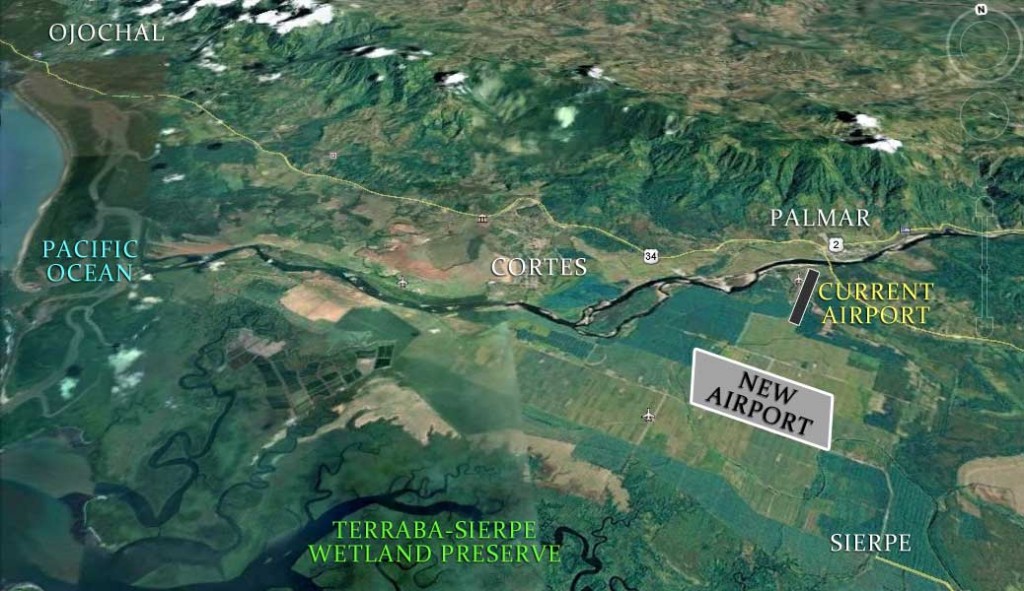The strongest principle of growth lies in the human choice. – George Eliot
Now that the Costanera Sur (Coastal Highway) has been completed, the new international airport for the southern Pacific zone is the single, most popular, regional question we receive. Most investors want it. Most environmentalists are alarmed by the thought of it. But, everybody wants to know how it is progressing and when/if it will be built.

As per a recent report in the July edition of Enlace, a small local newspaper here in the southern Pacific zone, the Costa Rican government just concluded a meeting to determine the future of the International Airport in the area. They also discussed how this airport would also be the 1st “green” airport in Latin America.
Another Airport Article?
I’m skeptical when I see news articles for the new International Airport in the Sierpe/Palmar area. There has been talk of building this airport since I moved here in 2006. Although Costa Rica has developed by leaps and bounds over the last 10-15 years, slow progress is the custom here. The difference with this recent announcement is that the OACI (Organización de Aviación Civil Internacional), in conjunction with investors and local government groups, has selected two companies to complete a comprehensive impact study. With this study in hand, the project should be able to make a case for construction.
The two independent groups are Acciona IngenierÍa, a company from Spain, and a Costa Rican environmental consultants Inforest Consultores Ambientales. I couldn’t find any press releases on their respective websites, but according to the Enclace article the studies will include geological, hydro, archeological and aviary analysis. The aviary report, which includes the migratory patterns of various bird groups native to the Osa Peninsula and beyond, is expected to be completed in 14 months while the other findings are expected to be completed in nine. They will also research the expected socio-economic impact for the region, and as I wrote in my 2010 article, a number of hotels will need to be built on the Costa Ballena in order to accommodate 300+ new arrivals per day. With a price tag of $998,300, I imagine the government is confident it will receive a positive result.
Building It “Green”
I didn’t even know a “green airport” was possible until I started reading up on it. England, the U.S., India, and Switzerland are just a few countries that have either achieved “green” certification or are adopting sustainable energy systems and transportation, and use recycled building methods. According to the article, Costa Rican government wants to use these methods to make this new airport the first certified “green” aeródromo in Central America.
The Osa Peninsula, specifically the Corcovado National Park, was once described as “the most biologically intense place on the planet” by National Geographic magazine. Eco-tourism draws thousands of tourists, students and environmentalists to the area every year. The Minister of Air Transportation seems to get this bigger picture when he said, “The master plan will contemplate each phase of design, construction and operation. It will be constructed using specific criteria and specialized techniques to guarantee the protection and conservation of the ecological resources and habitats.”
Whether it is possible to protect a wetland habitat adjacent to an airport remains to be seen, but the companies appear set to do their due diligence. Over the course of the next 14 months, Inforest Consultores Ambientales will be measuring the migration patterns of the various birds species in the immediate wetland areas. Specifically, they want to know exactly when these bird species will be on the move. Their intention is to cancel a time frame of flights (common in other areas) that may impact the well being of these species. They are also planning to protect 7,000 hectares of wetlands in the surrounding area into perpetuity.

The original (and obvious) idea for the airport was to expand the current regional airport in Palmar to accommodate planes capable of traveling longer distances and carrying more people. What those initial studies determined was the mountain range directly east of the location made it a potentially dangerous fly zone, not to mention the entire town of Palmar would need to be moved and the property owners compensated for being displaced.
The new and current plan involves locating the airport on Fincas 9 and 10 in Sierpe (see image). This location is less than 5 minutes from the current Palmar Regional Airport on flat land that is/was used for banana and date palm plantations. I’m not an aviation expert, but these flat, contiguous parcels do seem to offer a better orientation for take offs and landings.
The landing strip will be 2.2km, one less than the Int’l airport in San Jose and with a main terminal building that will be five times smaller than the recently expanded airport in Liberia. It will service small planes, corp. jets, and (most important for tourism) the 190 and 320 Airbuses capable of carrying up to 150 passengers. Clearly, the thought of driving 30 minutes to the Costa Ballena instead of 3 hours is appealing to many tourists, business owners, and investors.
Pros and Cons-clusion
The problem for environmentalists is the proximity to the Terraba-Sierpe National Wetlands and the wildlife contained therein. They also point to Costa Rica’s wildlife as the main reason people visit the area. Investors, hoteliers and business owners are hoping the two companies conducting the studies will be able to show that the impact on the environment will be minimal and/or off-set by the “green” building materials and sustainable energy sources, so it can move forward. For better or worse, the future of the area will be dramatically affected by these reports.
